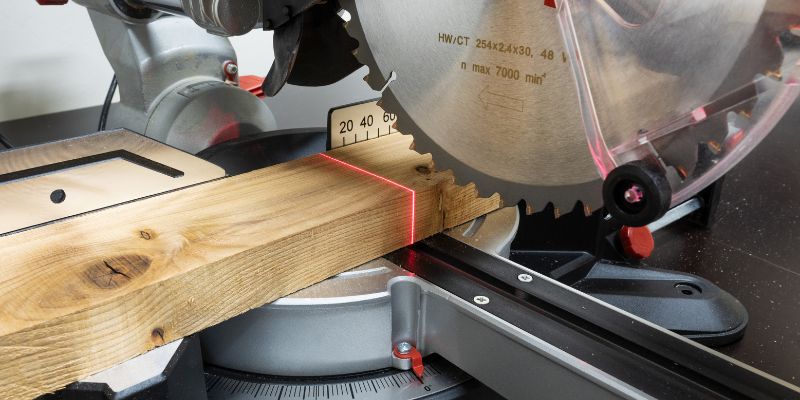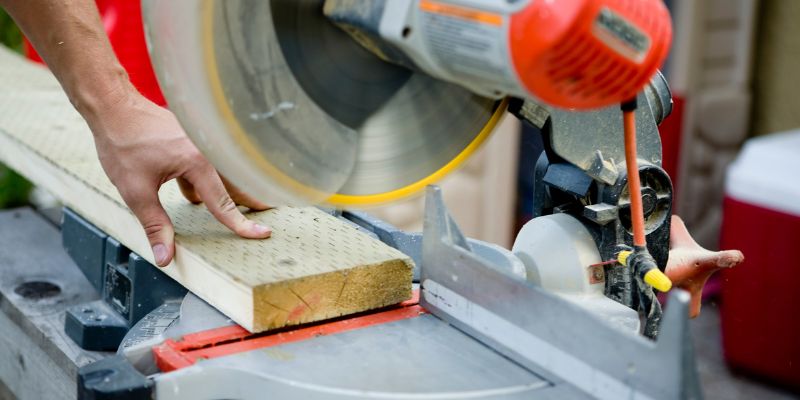For typical DIY and home improvement projects, a 10-inch miter saw is sufficient. For larger and heavier materials, a 12-inch miter saw would be more suitable.
Keep in mind the types of projects you will be working on and the sizes of the materials you will be cutting when determining the size of miter saw you need. The size of a miter saw refers to the diameter of the blade it can accommodate.
A larger blade allows for cutting wider and thicker materials. If you’re a homeowner or DIY enthusiast looking to take on various woodworking or construction projects, selecting the right miter saw size is crucial. Understanding the differences between a 10-inch and a 12-inch miter saw and their respective capabilities will help you make an informed decision for your specific needs. Whether it’s for making precise angled cuts in molding or framing, having a suitable miter saw size ensures efficiency and accuracy in your work.
Choosing The Right Miter Saw Size
Before investing in a miter saw, it’s crucial to assess your project needs and factor in the importance of blade size. The right miter saw size can significantly impact the precision and efficiency of your cutting tasks. Let’s delve into the process of determining the appropriate miter saw size for your projects.

Assessing Project Needs
When choosing a miter saw, assessing your project needs should be the primary consideration. Analyze the type of projects you commonly undertake and the materials you frequently work with. Are you mainly cutting small moldings or large pieces of lumber? The nature and size of your projects will guide you in selecting the appropriate miter saw size.
Importance Of Blade Size
One of the key factors in determining the right miter saw size is the blade size. The size of the blade directly impacts the cutting capacity of the saw. Larger blades provide the ability to cut wider and thicker pieces of material, while smaller blades are more suitable for intricate and detailed cuts. Considering the materials and dimensions of your typical projects will help in determining the necessary blade size for your miter saw.
Uses Dictating Miter Saw Size
Choosing the right miter saw size is crucial for tackling various woodworking projects effectively. The uses and tasks you intend to carry out will determine the size of the miter saw that best fits your needs. Let’s explore how different tasks and project sizes can dictate the miter saw size you need.
Comparing Common Tasks
Different woodworking tasks require specific miter saw sizes to ensure precision and efficiency. Here’s how the common tasks compare:
- Crown molding: For intricate crown molding projects, a larger miter saw with a bevel and compound features is ideal for accurately cutting the molding at the required angles.
- Trim and framing: When working on precise trims and framing, a mid-sized miter saw is suitable as it offers versatility and accuracy for straight and angled cuts.
- Furniture making: Creating furniture pieces often involves varying lengths and angles, necessitating the use of a larger miter saw with adjustable features for enhanced flexibility.
Small Versus Large Project Considerations
The scale of your woodworking projects plays a significant role in determining the miter saw size required. Consider the following when deciding on the appropriate miter saw size:
- Small projects: For small-scale tasks like picture frame assembly or basic trim work, a compact miter saw can provide the necessary cutting precision without occupying excessive space in your workshop.
- Large projects: When undertaking substantial woodworking projects such as building decks, constructing large furniture pieces, or extensive home renovations, a larger, more powerful miter saw becomes essential for handling the materials with ease and precision.
What Size Miter Saw Do I Need : Discover The Perfect Fit
Choosing the right miter saw size is crucial for your woodworking projects. It ensures precision, efficiency, and safety. To help you find the perfect fit, consider the following factors:
Analyzing Types Of Cuts Required
Before determining the size, analyze the types of cuts you’ll frequently make. If you often work with large crown molding or baseboards, a 12-inch miter saw provides the necessary capacity. For smaller trims or light-duty tasks, a 10-inch miter saw may suffice. Understanding your specific cutting needs is critical in selecting the right size.
Consideration For Future Projects
When choosing a miter saw size, consider your future projects. Investing in a larger saw may be beneficial if you anticipate working on larger or more complex projects in the future. It not only enhances versatility but also saves you from needing to upgrade later. Opting for a larger size as a long-term investment can prove to be cost-effective.
Miter Saws For Various Materials
Miter saws are incredibly versatile tools that can be used for a wide range of cutting applications. Depending on the material you plan to work with, it’s essential to select the right miter saw size and blade type to ensure precision and efficiency in your cutting projects.
Cutting Capacities For Wood, Plastic, Metal
When it comes to cutting various materials, it’s important to consider the cutting capacities of the miter saw. Different materials require different cutting depths and angles to achieve precise cuts.
Impact Of Material On Blade Choice
Choosing the right blade for the material you’re working with is crucial for achieving clean and efficient cuts. Wood, plastic, and metal each require specific blade types to ensure optimal performance and safety.

Essential Features Beyond Size
When choosing a miter saw, it’s important to consider essential features beyond just the size of the blade. These features can significantly impact the precision, efficiency, and overall performance of the tool. Let’s explore some of the key features to look for beyond the size of the miter saw.
Motor Power And Speed
The motor power and speed of a miter saw are crucial factors to consider. A powerful motor ensures that the saw can cut through various materials with ease, while higher speed allows for smoother and more efficient cuts. Look for a miter saw with a high-power motor and adjustable speed settings to handle a wide range of cutting tasks, from delicate trim work to heavy-duty framing projects.
Laser Guides And Dust Collection
Laser guides can greatly enhance cutting accuracy by providing a precise visual reference for the cut line. When shopping for a miter saw, opt for a model equipped with built-in laser guides to ensure precise and consistent cuts every time. Additionally, effective dust collection is essential for maintaining a clean and safe work environment. Choose a miter saw with an integrated dust collection system to minimize airborne dust particles and keep your workspace clutter-free.
Maximizing Miter Saw Capabilities
Making the most of your miter saw’s capabilities is essential for maximizing its value and efficiency. Choosing the right size miter saw is just the beginning; accessorizing and extending its functionality add versatility, ensuring you can tackle a wide range of projects with ease. Let’s delve into how to make the most of your miter saw’s capabilities.
Accessories And Extensions
Miter saws can be enhanced with various accessories and extensions to expand their usefulness. Here are some popular add-ons:
- Extension wings: These provide extra support for longer workpieces, making it easier to cut larger materials with precision.
- Clamps and stops: These accessories help secure workpieces and ensure accurate, repeatable cuts.
- Dust collection systems: Keeping work areas clean and reducing airborne dust is critical for a safer and more efficient woodworking environment.
- Custom jigs and fixtures: Tailor-made accessories can be designed to match specific project requirements, such as picture frames or crown moldings.
Importance Of Choosing Versatility
Opting for a versatile miter saw size ensures that you can handle a wide array of projects without limitations. A versatile saw can accommodate various blade sizes, offer a wide range of miter and bevel cuts, and have ample cutting capacity for different materials. This adaptability allows you to take on diverse woodworking tasks, from crafting intricate picture frames to constructing large furniture pieces with ease.
Frequently Asked Questions For What Size Miter Saw Do I Need
What Are The Different Sizes Of Miter Saws?
Miter saws come in various sizes, including 7. 25, 8, 10, and 12 inches. The size refers to the diameter of the blade. The best size for you depends on the type of projects you plan to tackle.
How Do I Determine The Right Miter Saw Size For My Projects?
Consider the largest stock you’ll be cutting, as the saw blade should comfortably handle this size. Additionally, factor in the type of cuts you intend to make, such as bevel or compound cuts, to determine the ideal miter saw size for your needs.
What Type Of Projects Require A Larger Miter Saw Size?
Projects such as cutting wide crown molding, large baseboards, and heavy timber may require a larger miter saw size, such as 10 or 12 inches. A larger size allows for more cutting capacity and versatility in handling various materials.
Are There Any Advantages To Using A Smaller Miter Saw Size?
Smaller miter saw sizes, like 7. 25 or 8 inches, are more compact and portable, making them suitable for smaller workspaces or jobs that require mobility. They are also often more affordable and can handle most DIY and light woodworking projects.
Conclusion
To wrap up, choosing the right miter saw size depends on the type of projects you’ll be tackling. By considering the cutting capacity and versatility, you can find a miter saw that meets your needs. Understanding your requirements and the saw’s features will ensure you make the best choice.
Happy sawing!


